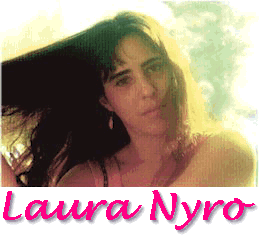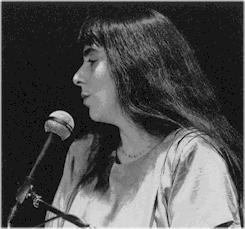![]()
(Taken from Laura's
Anthology)
![]()
| On Stoned Soul
Picnic: The Best Of Laura Nyro, a compilation of her
twenty-five years with Columbia Records, the innovative
artistry of Laura’s singing and songwriting is in
full celebration. Contained in this collection are her
original songs of spiritual, social and sensual vision.
Experimenting with form and feeling, her work shares a
connection with modern poetry and art. Her songs have
inspired musicians and music lovers for over three
decades. “I would go out singing, as a teenager, to a party or out on the street, because there were harmony groups there, and that was one of the joys of my youth,” Laura says of her musical roots. “I mean you could just go out and sing. If I look back now, all these years later, I must have had a spiritual, holistic feeling from all of that.” When asked about her approach to songwriting, that perhaps she is of the generation who addresses certain issues, and what her responsibility is to express those issues - Laura replies: “I’m not interested in conventional limitations when it comes to my songwriting. For instance, I may bring a certain feminist perspective to my songwriting, because that’s how I see life. I’m interested in art, poetry, and music. As that kind of artist, I can do anything. I can say anything. It’s about self-expression. It knows no package - there’s no such thing. That’s what being an artist is.” By age 17, she had written the classic “And When I Die,” popularized by Peter, Paul and Mary, and later Blood, Sweat and Tears. The radio airwaves of the late ‘60’s and ‘70’s were filled with her songs. “Wedding Bell Blues,” “Stoned Soul Picnic,” “Blowin’ Away,” “Save The Country,” and “Sweet Blindness,” a bouquet of compositions, all became hits for The Fifth Dimension, as did “Eli’s Comin’” for Three Dog Night, and “Stoney End” for Barbra Streisand. “She wrote the most unexpected songs,” observer Stereo Review, “a dazzling display of lyrical and musical innovation that gave her music a fresh feeling….” Laura’s work draws from soul, jazz, blues, R&B, and folk-rooted music, along with a modern classical influence. Her songs have been recorded by artists as diverse as Carmen McCrae, Suzanne Vega, Phoebe Snow, Roseane Cash, Sweet Honey in the Rock, Jane Siberry, Mongo Santamaria, Junior Walker and the All Stars, Chet Atkins, Frank Sinatra, Linda Ronstadt, George Duke, Maynard Ferguson, Thelma Houston, Patti Larkin, The Roches, and many, many others. The prestigious Alvin Ailey Dance Company includes Laura’s music in their performance piece “Cry.” And the Canadian Ballet has danced to “Emmie.” |
 |
| Born in New York
on October 18, 1947, Laura was brought up on city life
and summers spent in the lush greenery of the Northeast.
She began playing music very early, and enjoyed a wide
range of influences through her high school years at
Manhattan’s Music and Art. Laura listened to the
late ‘50’s and ‘60’s girl groups,
Nina Simone, John Coltrane, Miles Davis, Smokey Robinson
and the Miracles, Curtis Mayfield and The Impressions,
Mary Wells, Dusty Springfield, and the early Burt
Bacharach-Hal David songs of Dionne Warwick, among many
others. Laura read poetry and at home her mother played
records by Leontyne Price and impressionist classical
composers such as Ravel, Debussy and Persicetti. Throughout high school Laura also listened to the protest music of Pete Seeger, Joan Baez, early Bob Dylan the Beatles and others. Laura always "adored" the music of Van Morrison. “I was always interested in the social consciousness of certain songs. My mother and grandfather were progressive thinkers, so I felt at home in the peace movement and the women's movement, and that has influenced my music.” Laura made her first extended professional appearance at age 18, singing at the legendary Hungry i coffeehouse in San Francisco Sound.” The following year (1966) saw the release of her debut album More Than A New Discovery on the Verve/Folkways label. It’s still interesting to note that her Verve label-mates then included The Blues Project, Tim Hardin, Richie Havens, Janis Ian, and Dave Von Ronk; other seminal New York peers included Tim Buckley and Kenny Rankin. Laura joined Columbia Records in 1968 and released Eli And The Thirteenth Confession, “the work of an original and brilliant young talent,” (as Jon Landau wrote in Rolling Stone). The summer of 1969 brought New York Tendaberry followed by Christmas And the Beads of Sweat at the end of 1970. These three albums represent a litany of songwriting craft to this day. One year later came Gonna Take A Miracle, Laura’s impressionistic cover album of the soul songs of her youth. In 1973, her Verve debut album was acquired and reissued by Columbia as The First Songs. “When I was working on this anthology, and listening back to that music,” Laura says of these early recordings, “I thought ‘Oh my God - what a madcap energy. I don’t know if I can deal with this.’ (laughs) But it’s funny because soon I started to get into it and it was very energizing. And a lot of fun. I cried when I heard New York Tendaberry.” Following Gonna Take A Miracle, Laura recorded Smile in 1976. She then embarked on a four-month tour with a full band, which resulted in Season Of Lights, a “live” album (1977). Her next album, Nested, in 1978, continued Laura’s explorations of sound and color. Of the shows that followed the release of Nested she recalls, “That tour was special, because I was pregnant at the time and I sang up until a few weeks before I had the baby. I’d sing new originals and just drift into the old Curtis Mayfield and The Impressions songs.” “Eight months pregnant, Laura Nyro played The Bottom Line in four sold-out performances,” wrote Tom Windbrandt in The Soho News. “The show was almost understated in its simplicity. Ms. Nyro wore a red strapless dress and performed without any back-up musicians at all. What the performance lacked in texture, it made up for in intimacy. It was almost like having Laura in one’s own living room. The baby figured into the between-song-patter: ‘We’re both really happy to be here,’ she announced.” In 1984 Laura released Mother’s Spiritual, a major work of 14 original songs. The lyrics were presented at the Chicago Peace Museum. In 1988, at age 40 and in fine voice, Laura took her music on the road again, playing concerts around the country, which resulted in her second “live” recording - Laura-Live At The Bottom Line, (released on Cypress/A & M, 1989). “I quit smoking and it made my instrument richer and more stable,” she said at the time. “I have this new band,” she added, referring to the group led by guitarist Jimmy Vivino. “And we have a lot of vitality.” The album drew upon a combination of Laura’s classic compositions and eight original new songs featuring “Roll of the Ocean,” and the “Japanese Restaurant Song.” The tour was dedicated to the Animal Rights Movement. |
 |
| In 1993 Walk
The Dog And Light The Light arrived with the studio
version of “Broken Rainbow,” considered one of
Laura’s most important songs of social protest. It
was written for the film of the same name, which won the
Academy AwardŽ for Best Documentary of 1985.
“Broken Rainbow” is about the unjust relocation
of the Navajo people. A
working musician, Laura has spent much time during her
twenties, thirties and forties on the road, singing in
clubs and concert halls throughout America and abroad,
including her return to Japan in 1994. “The Japanese
tour was the ultimate fun. I brought my harmony group,
and we sang three nights in Tokyo, then took the train to
Kyoto. It was very romantic. The language barrier
didn’t matter. The music was a universal soul
connection.” |
 |